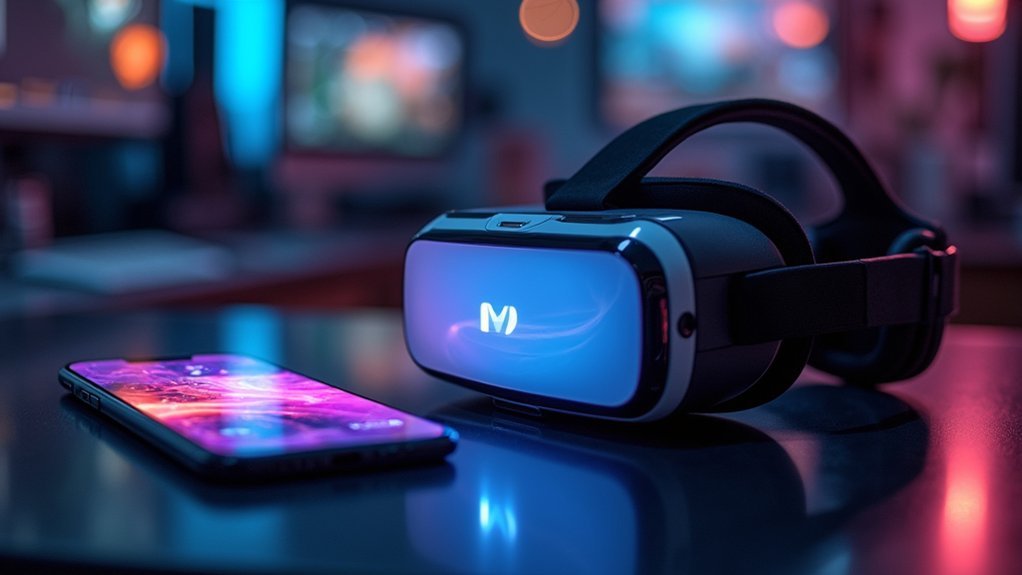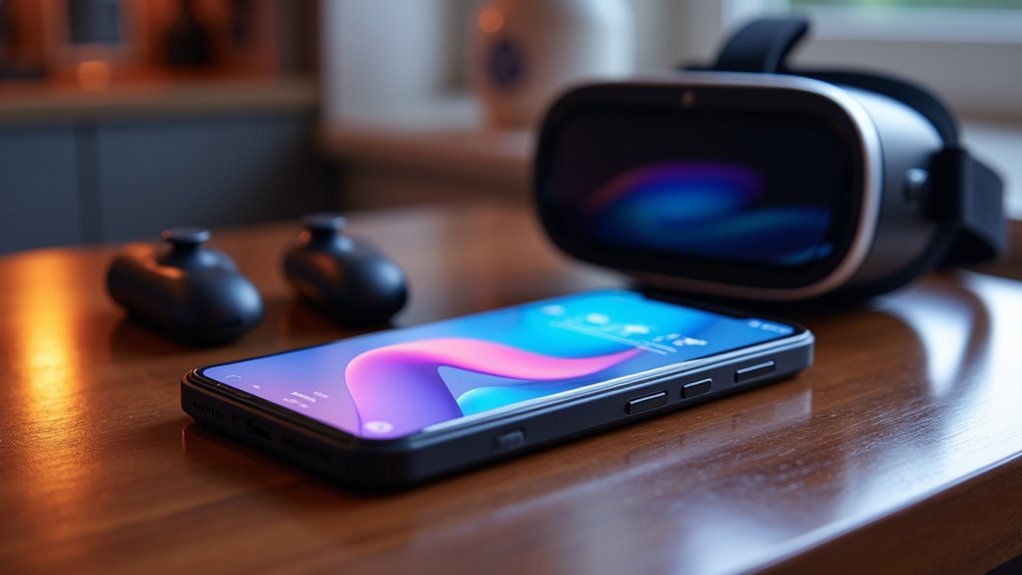You’ll need a smartphone with specific hardware to use wireless VR headsets effectively. Compatible phones include iPhone 8 or newer with iOS 14.4.2+, Samsung Galaxy S21/S20/S10 series with Exynos processors, and Google Pixel 3XL/4XL models. Your phone must have a built-in gyro sensor, 5GHz Wi-Fi capability, and a screen size between 4.7-6.8 inches for proper headset fit. Understanding these requirements and troubleshooting steps can help you optimize your wireless VR experience.
Understanding Wireless VR Technology and Phone Compatibility

While traditional VR headsets tether you to a computer or console, wireless VR technology liberates your experience by connecting directly to your smartphone’s processing power and connectivity features. Your phone becomes the engine driving your mobile VR headset, handling everything from graphics processing to motion tracking.
Your smartphone transforms into a powerful VR engine, eliminating cables while delivering complete graphics processing and motion tracking capabilities.
For peak performance, you’ll need a smartphone that meets specific technical requirements. Your device must support 5GHz Wi-Fi and Bluetooth connectivity to guarantee smooth streaming and seamless interaction.
The VR experience quality depends heavily on your phone’s processing capabilities and software compatibility.
Not every smartphone works with every VR headset. You’ll find that manufacturers often specify compatible devices, such as newer Samsung phones with particular firmware versions or recent iPhones with updated operating systems, ensuring your investment delivers the immersive experience you expect.
Iphone Models That Support Wireless VR Headsets
When choosing an iPhone for wireless VR, you’ll need an iPhone 8 or newer running iOS 14.4.2 or later to guarantee proper compatibility.
Your iPhone must have a built-in gyro sensor for ideal performance with any Virtual Reality Headset.
The iPhone 11 series delivers excellent wireless VR experiences, while the iPhone 12 lineup offers enhanced performance.
These newer models provide the processing power and sensors necessary for smooth VR interactions.
Key iPhone compatibility requirements include:
- iPhone 8 or newer model with iOS 14.4.2 minimum
- Built-in gyro sensor for motion tracking
- iPhone 11 series and iPhone 12 Mini/12/12 Pro/12 Pro Max specifically supported
- Sufficient processing power for wireless VR headsets
Your iPhone’s compatibility guarantees seamless connectivity with supported VR headsets, delivering immersive virtual reality experiences without compromising performance quality.
Samsung Galaxy Phones Compatible With Wireless VR

Samsung Galaxy phones offer robust wireless VR compatibility across multiple flagship series, with the Galaxy S21, S20, S10, and Note models delivering exceptional virtual reality performance.
You’ll need an Exynos-based processor and specific firmware versions to access peak wireless VR functionality on your Samsung Galaxy device.
To maximize your experience with VR headsets like the VIVE Flow, you’ll want to pair compatible VR controllers or accessories with your phone.
This combination grants the full range of immersive features available in virtual reality applications.
Keep your Samsung Galaxy updated to the latest software version to maintain compatibility with new wireless VR features and enhancements.
This guarantees you’ll have access to the rich selection of content and applications that make these VR headsets truly compelling for entertainment and productivity.
Google Pixel and Android Device Compatibility
Google Pixel phones deliver excellent wireless VR compatibility, with the Pixel 3XL and 4XL standing out as particularly strong performers that leverage their built-in gyro sensors for ideal virtual reality experiences.
These Android devices work seamlessly with most mobile VR headset options on the market.
Your Android devices need specific requirements for peak VR headset performance:
- Screen sizes between 4.7 to 6.8 inches guarantee proper fit in mobile VR headsets
- Gyro sensors enable smooth head tracking and immersive movement detection
- Regular firmware updates activate wireless capabilities, especially for Exynos-based devices
- Compatible accessories like the Controller for VIVE Flow expand functionality when direct phone compatibility isn’t available
Google Pixel smartphones consistently meet these standards, making them reliable choices for wireless virtual reality adventures.
Essential Phone Specifications for Wireless VR Performance

Performance in wireless VR hinges on your smartphone meeting several critical hardware and software requirements.
Your phone must include a gyro sensor, which tracks head movements precisely for immersive virtual environments. Without this essential component, you’ll experience poor motion tracking and reduced VR quality.
A gyro sensor ensures precise head tracking, making it absolutely essential for quality VR experiences on your smartphone.
You’ll need a robust Wi-Fi connection, preferably 5GHz, to handle smooth streaming and content mirroring.
Weak connections cause lag, stuttering, and degraded visual quality that ruins the VR experience.
Your device must also support HDCP 2.2 for proper content playback and streaming. This digital rights management protocol guarantees compatible VR applications function correctly.
Additionally, verify your smartphone runs current firmware versions, as manufacturers continuously update compatibility requirements.
These specifications work together to deliver peak wireless VR performance across different headset models.
Gyro Sensor Requirements for VR Functionality
When choosing a smartphone for wireless VR, you’ll find the gyro sensor stands as the most vital component for proper head tracking functionality. This essential sensor enables your VR headset to accurately detect and respond to head movements, creating truly immersive experiences that make virtual worlds feel real.
Without a gyro sensor, you’ll encounter significant limitations that severely impact VR quality:
- Reduced tracking accuracy leading to disorienting lag and drift
- Inability to look around virtual environments naturally
- Limited compatibility with advanced VR applications and games
- Poor overall immersion that breaks the virtual reality illusion
The V5 VR headset specifically requires gyro sensor functionality for ideal performance.
Popular compatible smartphones like iPhone 12 series, Samsung Galaxy devices, and Google Pixel phones all include this vital sensor, ensuring seamless VR functionality.
Operating System Requirements for Wireless VR Apps
You’ll need to meet specific operating system requirements before your phone can run wireless VR apps effectively.
iOS devices must run version 14.4.2 or later on iPhone 8 models and newer to guarantee compatibility with most wireless VR headsets.
Android users face more complex requirements, as compatibility often depends on both the operating system version and specific hardware configurations like Exynos processors.
Ios Compatibility Standards
Although Apple’s ecosystem offers robust VR support, you’ll need specific hardware and software requirements to enjoy wireless VR headsets. iPhone 8 and newer models running iOS 14.4.2 or later provide the necessary foundation for wireless VR compatibility, particularly with headsets like the VIVE Flow.
Your device must meet these essential criteria for peak performance:
- Hardware compatibility – iPhone 8 or newer models with sufficient processing power
- Software requirements – iOS version 14.4.2 or later for full feature access
- Regular updates – Keep both iOS and VR apps updated for enhanced compatibility
- Performance optimization – Confirm your firmware meets VR functionality standards
Without meeting these iOS compatibility standards, you’ll face significant limitations accessing wireless VR content and may experience reduced functionality with modern VR applications.
Android System Requirements
Android devices need specific system requirements to run wireless VR applications effectively. You’ll need Android 8.0 (Oreo) or higher to guarantee compatibility with the latest VR technologies. Your phone must support 5GHz Wi-Fi networks for seamless streaming and reduced latency during VR experiences.
Hardware requirements are equally important for your headset performance. Your Android devices must include a gyro sensor for ideal head tracking in VR environments. Many wireless VR Glasses manufacturers specifically recommend Exynos-based Samsung phones with firmware version 1.24.623.02 or higher for full functionality.
Keep in mind that compatible phone lists receive regular updates as manufacturers continuously test newer devices and operating systems. You should verify your specific device’s compatibility before purchasing any wireless VR equipment to guarantee peak performance.
Phone Screen Size and Resolution Considerations
When selecting a phone for wireless VR, you’ll need to contemplate screen dimensions between 4.7 and 6.8 inches for the best headset compatibility.
Your phone’s resolution directly impacts visual clarity, so you’ll want at least 1080p to avoid pixelated or blurry VR experiences. Higher resolutions above 1080p will give you sharper, more immersive visuals that make virtual worlds feel more realistic.
Optimal Screen Dimensions
Since wireless VR headsets rely heavily on your phone’s display to create immersive virtual worlds, choosing a device with the right screen dimensions becomes essential for a superior experience.
Your smartphone’s screen size directly impacts how well it’ll fit within the headset’s housing and how comfortable you’ll feel during extended sessions.
The ideal screen dimensions for most wireless VR headsets fall within specific parameters:
- Screen size range: 4.7 to 6.8 inches guarantees proper fit without gaps or overcrowding
- Resolution minimum: 1080p (1920 x 1080 pixels) for clear, sharp visuals
- Aspect ratio compatibility: 16:9 or 18:9 ratios work best with standard head strap configurations
- Pixel density: Higher PPI reduces screen door effect, unlike some Meta Quest limitations
These specifications guarantee your phone integrates seamlessly with wireless VR technology.
Resolution Quality Impact
Beyond selecting the correct screen dimensions, your phone’s resolution quality determines whether you’ll experience crisp, detailed virtual environments or spend your VR sessions squinting through pixelated imagery. You’ll need a minimum of 1080p resolution to achieve acceptable visual clarity, though higher resolutions greatly enhance your immersive experience.
| Resolution | Quality Level | VR Experience |
|---|---|---|
| Below 1080p | Poor | Pixelated, uncomfortable |
| 1080p | Good | Clear, acceptable |
| 1440p+ | Excellent | Sharp, immersive |
Your phone’s pixel density directly impacts visual sharpness in VR. Higher PPI values create noticeably clearer images, making virtual objects appear more realistic. Recent flagship devices like iPhone 12 series and Samsung Galaxy phones deliver exceptional resolution quality that transforms your VR sessions into truly engaging experiences.
Troubleshooting Common Phone Compatibility Issues
Although wireless VR headsets offer incredible immersive experiences, you’ll sometimes encounter frustrating compatibility issues that prevent your phone from working properly with your device.
Compatibility problems between smartphones and wireless VR headsets can disrupt your immersive experience and require systematic troubleshooting to resolve.
Before diving into VR, you need to verify your smartphone meets essential requirements. Your phone must have a gyro sensor for peak performance with headsets like the V5 VR and VIVE Flow.
Additionally, check that your device supports the headset’s specifications – VIVE Flow works with Exynos-based Samsung phones and iPhone 8 or newer models.
Common troubleshooting steps include:
- Updating your phone’s software and VR apps to required firmware versions
- Confirming 5GHz Wi-Fi and Bluetooth capabilities for seamless connectivity
- Restarting your phone and re-pairing with the headset
- Verifying compatibility specifications match your smartphone model
Frequently Asked Questions
How Do I Know if My Phone Supports VR?
Check if you’ve got a gyro sensor in your phone’s settings or specs. Download a VR compatibility app from your app store. Verify your screen’s between 4.7-6.8 inches for ideal experience.
What Phone Is Best for VR?
You’ll want an iPhone 12 series or Samsung Galaxy S series for top VR performance. These phones have essential gyro sensors and high-performance specs that’ll give you the smoothest virtual reality experience possible.
What Devices Can You Use a VR Headset On?
You can use VR headsets on smartphones, PCs, and gaming consoles. Compatible phones include iPhone 8 or newer and Samsung devices with gyro sensors, while PCs support tethered headsets like Meta Quest 3.
Does VR Work on Android Phones?
Yes, VR works on Android phones with gyro sensors. You’ll need compatible models like Samsung Galaxy series, OnePlus devices, or Google Pixels, plus proper firmware that meets your VR headset’s requirements.
In Summary
You’ll find that most modern smartphones from 2016 onward support wireless VR headsets, including recent iPhones, Samsung Galaxy devices, and Google Pixel phones. You’ll need to guarantee your phone has a gyroscope sensor, adequate processing power, and meets the minimum OS requirements. If you’re experiencing compatibility issues, check your phone’s specifications against the headset’s requirements and update your software. You can enjoy wireless VR with the right phone-headset combination.





Leave a Reply